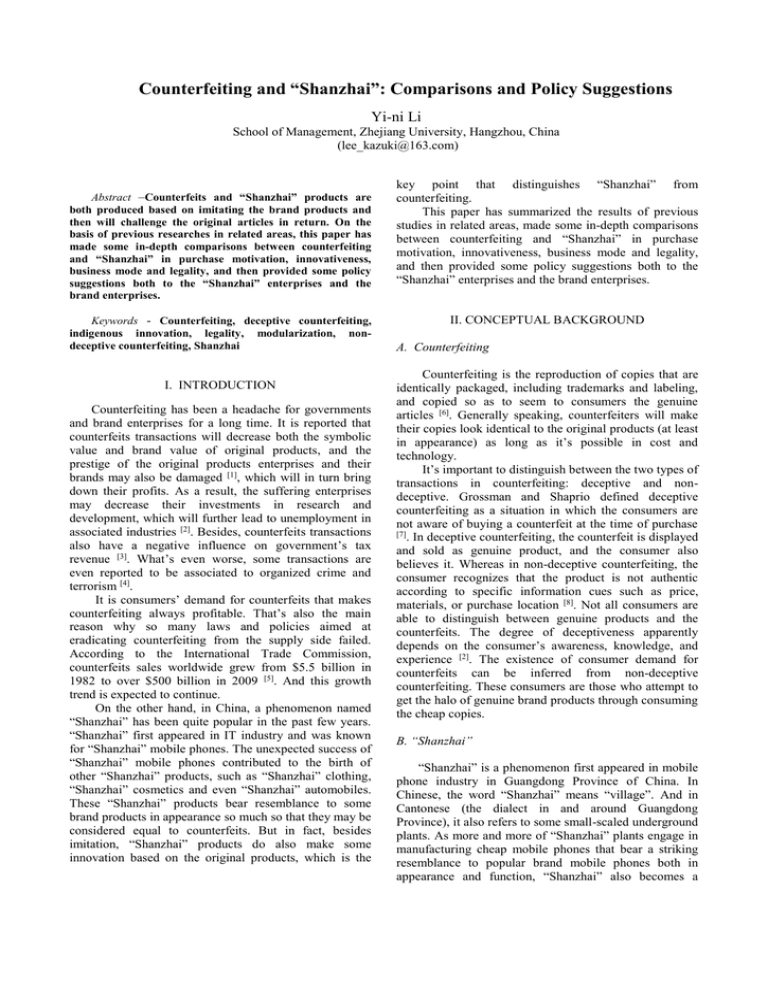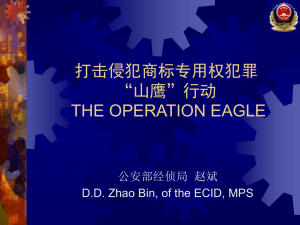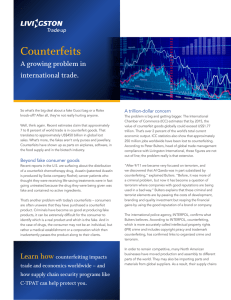“Shanzhai” from key point that
advertisement

Counterfeiting and “Shanzhai”: Comparisons and Policy Suggestions Yi-ni Li School of Management, Zhejiang University, Hangzhou, China (lee_kazuki@163.com) Abstract –Counterfeits and “Shanzhai” products are both produced based on imitating the brand products and then will challenge the original articles in return. On the basis of previous researches in related areas, this paper has made some in-depth comparisons between counterfeiting and “Shanzhai” in purchase motivation, innovativeness, business mode and legality, and then provided some policy suggestions both to the “Shanzhai” enterprises and the brand enterprises. Keywords - Counterfeiting, deceptive counterfeiting, indigenous innovation, legality, modularization, nondeceptive counterfeiting, Shanzhai I. INTRODUCTION Counterfeiting has been a headache for governments and brand enterprises for a long time. It is reported that counterfeits transactions will decrease both the symbolic value and brand value of original products, and the prestige of the original products enterprises and their brands may also be damaged [1], which will in turn bring down their profits. As a result, the suffering enterprises may decrease their investments in research and development, which will further lead to unemployment in associated industries [2]. Besides, counterfeits transactions also have a negative influence on government’s tax revenue [3]. What’s even worse, some transactions are even reported to be associated to organized crime and terrorism [4]. It is consumers’ demand for counterfeits that makes counterfeiting always profitable. That’s also the main reason why so many laws and policies aimed at eradicating counterfeiting from the supply side failed. According to the International Trade Commission, counterfeits sales worldwide grew from $5.5 billion in 1982 to over $500 billion in 2009 [5]. And this growth trend is expected to continue. On the other hand, in China, a phenomenon named “Shanzhai” has been quite popular in the past few years. “Shanzhai” first appeared in IT industry and was known for “Shanzhai” mobile phones. The unexpected success of “Shanzhai” mobile phones contributed to the birth of other “Shanzhai” products, such as “Shanzhai” clothing, “Shanzhai” cosmetics and even “Shanzhai” automobiles. These “Shanzhai” products bear resemblance to some brand products in appearance so much so that they may be considered equal to counterfeits. But in fact, besides imitation, “Shanzhai” products do also make some innovation based on the original products, which is the key point that distinguishes “Shanzhai” from counterfeiting. This paper has summarized the results of previous studies in related areas, made some in-depth comparisons between counterfeiting and “Shanzhai” in purchase motivation, innovativeness, business mode and legality, and then provided some policy suggestions both to the “Shanzhai” enterprises and the brand enterprises. II. CONCEPTUAL BACKGROUND A. Counterfeiting Counterfeiting is the reproduction of copies that are identically packaged, including trademarks and labeling, and copied so as to seem to consumers the genuine articles [6]. Generally speaking, counterfeiters will make their copies look identical to the original products (at least in appearance) as long as it’s possible in cost and technology. It’s important to distinguish between the two types of transactions in counterfeiting: deceptive and nondeceptive. Grossman and Shaprio defined deceptive counterfeiting as a situation in which the consumers are not aware of buying a counterfeit at the time of purchase [7] . In deceptive counterfeiting, the counterfeit is displayed and sold as genuine product, and the consumer also believes it. Whereas in non-deceptive counterfeiting, the consumer recognizes that the product is not authentic according to specific information cues such as price, materials, or purchase location [8]. Not all consumers are able to distinguish between genuine products and the counterfeits. The degree of deceptiveness apparently depends on the consumer’s awareness, knowledge, and experience [2]. The existence of consumer demand for counterfeits can be inferred from non-deceptive counterfeiting. These consumers are those who attempt to get the halo of genuine brand products through consuming the cheap copies. B. “Shanzhai” “Shanzhai” is a phenomenon first appeared in mobile phone industry in Guangdong Province of China. In Chinese, the word “Shanzhai” means “village”. And in Cantonese (the dialect in and around Guangdong Province), it also refers to some small-scaled underground plants. As more and more of “Shanzhai” plants engage in manufacturing cheap mobile phones that bear a striking resemblance to popular brand mobile phones both in appearance and function, “Shanzhai” also becomes a name for these products. These products imitate the appearance of brand mobile phones, combine their functions and also make some innovation. Thus, these “Shanzhai” mobile phones are not only cheap but also multifunctional, which makes them quite competitive. In 2007, 150 million “Shanzhai” mobile phones were produced, and the market share was over 25% [9]. The unexpected success of “Shanzhai” mobile phones contributed to the birth of other “Shanzhai” products, Such as cosmetics, clothing and even automobiles. Due to the popularity of “Shanzhai” products, the word “Shanzhai” became familiar to people, and turned to be the name of certain economic phenomenon that was characterized as imitative [10]. Nowadays, “Shanzhai” can be used to refer to any imitating activity or its products. III. COMPARISONS BETWEEN COUNTERFEITING AND “SHANZHAI” A. Purchase Motivation As is previously discussed, in counterfeits transactions, there are deceptive transactions and nondeceptive transactions. In deceptive counterfeiting, a counterfeit is sold to a consumer as genuine article. And the consumer is not aware of that at the time of purchase. In this situation, the consumer does not have any motivation to buy counterfeit. In a word, the consumer’s subjective process in deceived counterfeit purchase is quite the same as that in authentic product purchase. But as to the undeceived consumers, why do they knowingly buy these products? As is revealed by some researches, on the one hand, consumers can use counterfeits in a carefree manner without thinking about their material value [2]. One the other hand, people desire to associate with the current social class they are in or the class above them, and they will purchase brand products that convey affluence, wealth, and social class [11]. When the symbolic meaning of a brand product is quite important and the price is unaffordable or unreasonable to a consumer, he or she is more likely to choose the cheap substitute— counterfeit. Likewise, it is also for the lower price and the symbolic meanings brought by the appearance similar to brand products that consumers buy “Shanzhai” products. “Shanzhai” products utilize the symbol brand, and diminish the gap between the selling price and the usevalue of famous brand products with the low price [12]. For the target group of “Shanzhai”products, which consists of students, migrant workers, and those low-income white-collar workers, “Shanzhai ” makes fashionable and high-tech products cheaply accessible. Both counterfeits and “Shanzhai” products are attached to or depend on mainstream products. And the transactions of counterfeits and “Shanzhai” products have somehow acknowledged and further reinforced the leading role of mainstream products and the culture they represent for. However, different from counterfeits, the innovation “Shanzhai” products make have also somehow distinguished them from mainstream products and conveyed resistance to mainstream culture [13]. B. Innovativeness Both counterfeiting and “Shanzhai” are based on the imitating of existing popular brand products. However, although some uncompetitive “Shanzhai” enterprises may transform into counterfeiters [14], and some counterfeits may also label themselves as “Shanzhai” for a better fame, the fundamental difference still lies in different degree of innovativeness: counterfeits will copy the genuine articles as much as possible, whereas “Shanzhai” will make some innovation in addition to imitation in appearance and function. As long as it’s possible in cost and technology, counterfeits will copy everything of authentic articles such as appearance, design, materials, and functions. An “excellent” counterfeit will be strict in every detail, even a small warranty card. Whereas “Shanzhai” will imitate, combine, and then innovate the appearance and functions of brand products, and then produce their own “Shanzhai” products that may defeat the original articles in appearance, function and price. Take the representative “Shanzhai ” product mobile phone as an example. In a total solution for mobile phone named “turn-key” invented by the Taiwanese company “Media Tek”, motherboard, communication module and system software are all integrated together in a small chip. With this chip, “Shanzhai” manufacturers can easily assemble powerful cell phones by connecting modules, such as shell, screen, battery, and camera, to the standardized interfaces of the chip [15]. As a result, a number of multifunctional “Shanzhai” are produced. Some just looks like a watch, and some looks like a PSP. Some can function as pinhole camera, and some are even waterproof. All of this makes “Shanzhai” mobile phone far more than a mere copy of brand phone. C. Business Mode Counterfeiting is an unsupervised underground activity. Counterfeiters will never intentionally publish anything about themselves. So what is known about them is relatively limited. It is only reported that they are some small-scaled plants with little core technology or competence, hiring low paid but overtime working workers, using materials below standards, producing unauthorized copies that look similar or even identical to authentic brand products [4]. Then these counterfeits will be sold in black markets to consumers aware or not of what these products really are. The only “advantages” of counterfeiting may be low investment, little supervision, and little tax. On the other hand, the success of “Shanzhai” lies largely in its unique business mode: consumer-oriented innovation, modularized production, and multiple marketing channels. Product is the foundation of marketing. Any marketing activity should be based on its product. “Shanzhai” manufacturers usually adopt customeroriented policy in the process of innovation. One of the main reasons why “Shanzhai” products are so popular is that they can satisfy various demands of consumers in the market. “Shanzhai” manufacturers develop different products up to different consumer groups. They may even customize new products according to the need of specific customers, which makes customer-oriented mass customization [15]. Therefore, “Shanzhai” manufacturers could timely know from their customers any slight change in the market, and then immediately develop distinctive updated products according to the new demand. Through customer-oriented innovation policy, the manufacturers can lower the market risk and avoid the failure caused by information asymmetry [16]. The concept of modularization first appeared in machine design area at the beginning of the 20th century. It refers to based on the division of labor, dividing a complex system into several independent functional modules, and reassembling them into a new complete system with interfaces after all the modules are individually implemented [15]. Modularization can simplify complicated problems. In modularization, modules can be integrated together smoothly as long as each one is designed and implemented up to the standard. Due to modularization, “Shanzhai” manufacturers do not need to master the technologies and processes of all modules in the system, or to engage in the production of all of them. All they need to do is to focus on their core competency, produce the module in which they are competitive, and get the other modules through purchasing or outsourcing. The production cost of these manufacturers has also been dramatically brought down. Therefore, the innovation resources are efficiently utilized, which makes “progressive innovation” mode [15]. This production mode has promoted the specialization of industry chain for “Shanzhai”, and enabled the manufacturers in the chain to fully explore their advantages and rapidly respond to market. As a result, innovation becomes much easier. Improvement could be accomplished separately in each independent functional module, which changes complicated system innovation to an integration of simple module innovation. Besides the traditional channels such as retailers and wholesalers, the main marketing channels of “Shanzhai” products also include internet, TV home shopping and sales conventions. All these make a comprehensive marketing system of “Shanzhai”. Through these diversified channels, “Shanzhai” products can reach to their target consumers at any social class or any place easily and rapidly. This has dramatically improved the competitiveness of “Shanzhai”. D. Legality As business modes adopted by small enterprises that are lack of core technology or competence, both counterfeiting and “Shanzhai” are somehow attached to authentic brand products, and “seal” or “share” the added value brought by the brand symbol of authentic articles. However, counterfeiting is definitely illegal. But as to “Shanzhai”, although often involved in copyright infringement issues, the legality of “Shanzhai” still can not be uniformly defined because of its innovative elements. Both deceptive counterfeiting and non-deceptive counterfeiting are illegal. Because counterfeiters are always unsupervised and adopt low-cost policy, the quality of their products can not be guaranteed. The consumers of counterfeits are running financial, performance and functional risks [17]. What’s even worse, their safety and health may also be threatened. On the other hand, counterfeits transactions may not only take away potential consumers of original products, but also damage their image. Especially in deceptive counterfeiting, the awful consuming experience will be mistakenly ascribed to original product and its enterprise. And the damage will be even greater if the deceived consumer conveys the mistaken judgment to his peer group. Moreover, counterfeiting may have a negative influence on government’s tax revenue. And inferior counterfeits will also damage the image of the industry and even the image of the country— that’s the very embarrassment “Made in China” are suffering today. On the other hand, “Shanzhai” is no longer a small enterprise special thing. Some local brand manufacturers in China also chose “Shanzhai” as a part of their business mode. For example, some local brand automobile manufacturers have produced their own “Shanzhai” cars based on imitation and modification of the appearance of some foreign prestigious brand cars. However, this kind of “Shanzhai” is at most a low-level innovation or, in fact, a trick to avoid the name of copying. The development of these enterprises will excessively rely on the original products, which is not conducive to long-term development. What’ more, there will be extra cost both in money and time for these enterprises when copyright infringement suit is brought against them. It is necessary to point out that some dishonest businessmen may also make evil use of the similarity in appearance of “Shanzhai” products to brand articles, and intentionally sell them as original ones. This situation is almost the same to deceptive counterfeiting and is no doubt illegal. IV. POLICY SUGGESTIONS A. To “Shanzhai” Enterprises “Shanzhai” is not a China special phenomenon. The history of the development of modem economy implies that imitation and innovation based on imitation is one of the main forces behind the growth of economy. For those who are at a low level of economic development, “Shanzhai” is a specific stage on their way to catch up with and surpass the advanced world level [18]. Many prestigious enterprises also used to resort to imitation and innovation based on imitation in the early stage of their business. For example, NIKE used to imitate the “Tiger” shoes of ASICS Company [14]. What’s more, about 60 years ago, “Made in Japan” also used to be considered as a representative for fake and shoddy products. However, through the efforts of Japanese people, Japan has become the largest electronic products manufacturer today [19]. Thus, for Chinese manufacturing industry, “Shanzhai” is an unavoidable stage in the process of development. In past few years, due to the growing number of “Shanzhai” enterprises, problems, such as homogenization and blind price war, have emerged [14]. To respond to new challenges, it’s quite necessary for “Shanzhai” enterprises to transform into a normative and independent innovative development pattern to get rid of the reliance on the imitation of brand products and then develop in a more healthy and sustainable way. The more indigenous innovative enterprises there are, the better it will be for the promotion of the indigenous innovation ability of China and the development of industrial and regional economy. To achieve the transformation, “Shanzhai” enterprises should improve the quality as well as the aftersell service of their products to upgrade the image. Besides, to gain and keep updating their own core technologies, it is advisable to cooperate with the research institutes with outstanding ability [14]. What’s more, in transformation, much more importance should be attached to intellectual property strategy. Because the leading enterprises often have many patents with which they monopolize technology, “Shanzhai” enterprises with weak awareness of intellectual property are often involved in copyright infringement issues. Therefore, independent innovative “Shanzhai” enterprises should act in accordance with norms, and apply for licensing agreement when it’s needed. On the other hand, during innovation, these enterprises should also construct their own patent system to protect their innovative achievements [14]. B. To Brand Enterprises Counterfeiting, especially deceptive counterfeiting will erode the brand assets of the original products. And along with non-deceptive counterfeiting, “Shanzhai” is taking over low-end market which is ignored by famous brand enterprises before. What’s more, even the traditional market shares of original products are slipping with the extension of product line of some successful “Shanzhai” enterprises [14]. It’s quite a challenge for brand enterprises to respond to the new competition in market. Here are some policy suggestions for them: Because it is the appearance of brand products that is most imitated by counterfeits and “Shanzhai” products, brand manufacturers should concentrate more on innovating and updating their products in appearance, design, materials and any visible aspect so as to make the original products distinctive and hard to imitate. Besides, as previously discussed, the popularity of “Shanzhai” products and counterfeits can also be a promotion for original articles. The leading role of brand products in fashion is reinforced by the consumption of the cheap copies and imitations. And even in consumption of counterfeits, there is still some positive effect to original products. For example, it is revealed in some researches that a number of counterfeit consumers take the using of the cheap copies as an opportunity to get used to the original articles. And if the try is satisfactory, these consumers will probably purchase the original articles in the next time [2]. Therefore, the key is to properly educate these consumers by stressing the irreplaceable aspects of original products, such as authenticity and brand connotation, and then conduct them to switch to original products and never slip back to counterfeits. What’s more, it is well worth paying more attention to those “aspirational” consumers who are trying to distinguish themselves from lower consumers and identify with upper elite consumers [4][20]. These “aspirational” consumers are always purchasing for status with relatively limited budgets. It is estimated that about 60% to 70% consumers are aspirational. Therefore, brand enterprises can attract these consumers by product line extension to reply to the challenge from counterfeits and “Shanzhai” products. For example, many luxury brands have introduced accessory lines which are more affordable, but with much greater profit margins [21]. V. CONCLUSION Both counterfeiting and “Shanzhai” are profit modes chosen by enterprises that are lack of core technology and competence. However, based on previous discussions, it is known that “Shanzhai” is the more advisable way. Definitely, there are still drawbacks in “Shanzhai”. For example, some “Shanzhai” products may be involved in intellectual property infringement or tax evasion. Some have imperfect after-sale system, and some may even cheat consumers. However, on the other hand, “Shanzhai” products do have enabled the masses to enjoy the convenience brought by new technologies at an earlier time and a lower price. What’s more, to some extent, “Shanzhai” has also helped to promote economic growth in China. All in all, “Shanzhai” is an unavoidable stage for Chinese manufacturing industry. And the key is to achieve innovation through imitation, and then turn to indigenous innovation, which makes sustainable development possible. On the other hand, brand manufacturers should try to make their products distinctive and hard to imitate, make full use of the positive effect brought by counterfeits and “Shanzhai” products, and pay more attention to the aspirational consumers so as to respond to the challenge in the market. REFERENCES [1] L. Zhou, and M. K. Hui, “Symbolic value of foreign products in the People’s Republic of China”, Journal of International Marketing, vol. 11, no. 2, pp. 36–58, 2003. [2] M. Eisend, and S. Pakize, “Explaining counterfeit purchases: a review and preview”, Academy of Marketing Review, no.12, 2006. [3] B. Yoo, and S. Lee, “Buy genuine luxury fashion products or counterfeits?”, Advances in Consumer Research, vol. 36, pp. 280–286, 2009. [4] D. S. Wall, and J. Large, “Jailhouse frocks: locating the public interest in policing counterfeit luxury fashion goods”, BRIT. J. CRIMINOL., vol. 50, no. 6, pp. 1094–1116, 2010. [5] M. E. Perez, R. Castano, and C. Quintanila, “Constructing identity through the consumption of counterfeit luxury goods”, Qualitative Market Research: An International Journal, vol. 13, no. 3, pp. 219–235, 2010. [6] H. Kay, “Fake’s progress”, Management Today, pp. 54–58, Jul. 1990. [7] G. M. Grossman, and C. Shapiro, “Foreign counterfeiting of status goods”, Quarterly Journal of Economics, vol. 103, no. 1, pp. 79–100, 1988. [8] J. Gentry, S. Putrevu, and C. Shultz, “The effects of counterfeiting on consumer search”, Journal of Consumer Behavior, vol. 5, no. 3, pp. 245–256, 2006. [9] W. Lin, “’Shanzhai culture’ and its cultural value identification with adolescents” (in Chinese), Journal of China Youth University for Political Sciences, no. 5, pp. 46–50, 2009. [10] H. Zhang, and W. Zhang, “Interpretation upon ‘Shanzhai’ culture in contemporary China”, Hundred Schools in Arts, vol. 119, no. 2, pp.45–49, 2011. [11] A. Nia, and J. L. Zaichkowsky, “Do counterfeits devalue the ownership of luxury brands?”, Journal of Product & Brand Management, vol. 9, no. 7, pp. 485–497, 2000. [12] J. Li, and F. Li, “A study on symbolization of ‘Shanzhai’: in a view of consumption culture” (in Chinese), Intelligence, no. 22, pp. 181, 2009. [13] D. Chen, “Imitation subculture: resistance and ridicule”, Academic Exploration, no. 1, pp. 107–110, 2009. [14] L. Yin, T. Li, Y. Cheng, and S. Qiu, “Study on the general disciplinarian of SHANZHAI phenomena and its policy suggestion”, Studies in Science of Science, vol. 28, no.3, pp. 321–328, 2010. [15] K. Dong, “The enlightenment of ‘cheap-copy-mobile’ on China’s manufacturing industries”, Forum on Science and Technology in China, no. 8, pp. 60–65, 2010. [16] H. Tao, Y. Li, and Z. Luo, “Formation mechanism of Shanzhai model and its implications to organizational innovation”, China Soft Science, no. 11, pp. 123–143, 2010. [17] C. H. Wee, S. J. Tan, and K. H. “Non-price determinants of intention to purchase counterfeit goods: an exploratory study”, International Marketing Review, vol. 12, no. 6, pp. 19–46, 1995. [18] X. Hu, “Survival boundary of ‘Shanzhai culture’ and its effect on self-development”, Journal of China University of Geosciences (Social Science Edition), vol. 11, no.4, pp. 63– 69, 2011. [19] Z. Zhai, “An exploration on ‘Shanzhai culture’” (in Chinese), Journalism Lover, no. 14, pp. 36–37, 2009. [20] J. M. Barnett, “Shopping for Gucci on canal street: reflections on status consumption, intellectual property and the incentive thesis”, Virginia Law Review, vol. 91, no. 6, pp. 1381–1423, 2005. [21] I. Bekir, S. E. Harbi, and G. Grolleau, “How a luxury monopolist might benefit from the aspirational utility effect of counterfeiting”, European Journal of Law and Economics, DOI 10.1007/s10657-011-9235-x, 2011.





